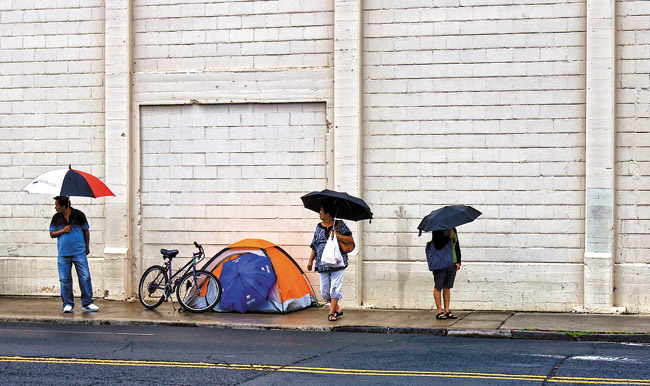Facing Up To The Homeless In Paradise
I was in Iwilei not long ago and noticed a huge encampment of homeless people lining a sidewalk. There were so many tents, tarps and shopping carts that I made a mental note to come back and take a closer look when I had some time.
I went back yesterday – the encampment had disappeared. But as I drove around the cramped streets of the industrial neighborhood, I realized they weren’t gone at all. They were just, well, spread out.
On every street, tiny tents clung like opihi to a corner of sidewalk here, against a wall there, to a bit of grass farther on down the way.
Sometimes I came across mini encampments, two or three or five at the most, connected by a thread invisible to me. Maybe they were friends or family members who didn’t want to be separated. Maybe they had banded together out of necessity – because there is strength in numbers, and it’s got to be scary out there on the streets.
People hate seeing these tent and tarp “villages” on our sidewalks and beaches and in the parks. But the solution has so far eluded policy makers and thoroughly confused the public.
There are those who would approach the problem as a humanitarian issue. There are many who just want to chase them away. There are plenty of people who choose to see the issue in black and white or, worse, who choose to not see it at all.
Many of the people who are most visible to us, those who occupy those tents and push around the carts, are chronically homeless. Some are mentally ill. A good many are drug addicts. Many of them choose to live their lives out in the open.
But most of the people who have no homes got that way because of illness or injury, the loss of a job, the high cost of rentals, domestic violence and who knows what other personal calamities in their lives. They don’t want to be part of the group that we collectively label “the homeless.”
The state categorizes “un-sheltered homeless” as the ones camped out in a public space with all of their worldly possessions or sleeping with their children their cars.
And there are those who are counted as “sheltered homeless” – individuals and families who are able to get into a public or private temporary shelter.
According to the 2013 “Point-in-Time Count,” conducted by the state Department of Human Services and the city’s Department of Community services, total homelessness on Oahu – both sheltered and unsheltered – has risen every year in the last five years.
What to do? Homelessness has been the bane of every state and city administration for years. Do we treat it as a mental health issue? A housing issue? A poverty issue? A jobs issue?
The answer has to be all of the above and more. There is no one solution to such a complex problem. It has to be attacked from all angles: giving law enforcement more ways to clear our public spaces; beefing up mental health services; providing more affordable rentals; improving the health of our economy; raising the minimum wage so people can afford to stay in their homes.
This year, state Sen. Suzanne Chun Oakland is talking up a bill that addresses the affordable housing part of the problem. It would provide $220 million to subsidize rentals for low-income people in Hawaii.
Now, if we’re being realistic, we know there is little to no chance that kind of money will be approved. But I admire the senator for at least attempting to keep the public’s attention focused on the problem.
We’re not the only city in the United States unable (or politically unwilling?) to solve this human crisis. That doesn’t mean it’s OK to quit trying. Also, I don’t think it matters why you want to fix the homeless problem as long as you agree it has to be fixed.
But that means we have to care. It means staring directly at the problem and resisting the urge to look away.
jmoonjones@yahoo.com
Twitter: @JadeMoon1






